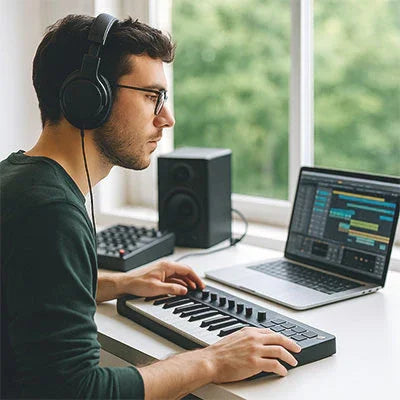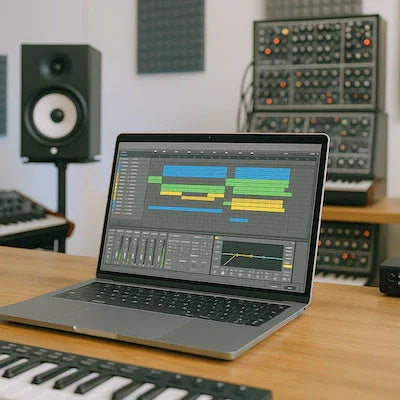So, you want to start writing music on your computer but aren’t quite sure where to begin? Don’t worry — you’re not alone. There’s a lot of information out there, and it can feel overwhelming. But the truth is, you don’t need a lot of gear or technical knowledge to start making music. You just need the right tools and a little guidance.
Let’s walk through what you actually need.
Computer or iPad – What’s Best for Music-Making?
The most important thing is having a device that can run music software. This is usually either a Mac, a Windows PC, or an iPad. Each one has its pros and cons, and the right choice depends on your workflow, your budget, and how portable you want to be.
Macs are widely used in music production, especially because of their smooth performance and software options like Logic Pro. PCs are just as capable and often more affordable, with a huge range of compatible music software available. Both platforms can run all the major music programs — so choose the one you’re more comfortable with.
An iPad is also a great option, especially for beginners who want to make music on the go. There are a ton of fantastic apps that let you record, build songs, and experiment with loops and sounds, all from a touchscreen. While not as deep as desktop software, iPads are a great way to sketch ideas or even build full tracks if you're using the right apps.
Whatever you choose, try to use a device with at least 8GB of RAM, a modern multi-core processor, and solid-state storage (SSD). These specs will help everything run smoothly.
Audio Interface – Connecting Instruments and Improving Sound Quality
Once you’ve got your computer or iPad, the next thing to think about is an audio interface. This little box acts as the bridge between your instruments, microphone, and computer. It allows you to plug in things like keyboards, guitars, or microphones, and also gives you better-quality sound when recording and listening back.
Audio interfaces usually connect via USB. They include one or more inputs for capturing sound and outputs for sending audio to your headphones or speakers. They also help reduce latency — that annoying delay between playing a note and hearing it.
Some mixers come with a built-in audio interface. These are especially useful if you want to record multiple things at once, like vocals and a keyboard, or if you’re working with other musicians. Mixers also give you physical control over volume and EQ, which can be really helpful when you're first starting out.
You don’t need a large or expensive interface to begin — just something reliable with the basic ins and outs you need for your setup.
MIDI Controller Keyboards – Making Music with Your Hands
A MIDI controller keyboard is a must-have for anyone who wants to play melodies, chords, or program beats. These keyboards don’t make any sound on their own. Instead, they send MIDI data (musical information) to your software, which then triggers sounds from your virtual instruments.
Most MIDI controllers today connect directly to your computer via USB and are instantly recognised by most DAWs. Some come with extra features like pads, knobs, and sliders, which can help you control other parts of your music software. It’s a hands-on, intuitive way to bring your ideas to life — much more natural than clicking notes into a piano roll with a mouse.
If you’re using an older MIDI keyboard with traditional MIDI ports, you’ll need a separate MIDI interface, which also connects via USB. But if you’re buying new, USB MIDI is the simplest and most beginner-friendly option.
DAWs – Your Creative Workspace
Your DAW (Digital Audio Workstation) is where everything comes together. It’s the software you’ll use to record sounds, arrange ideas, add effects, and mix your music. Think of it as your musical canvas.
There are many DAWs out there, and they all have slightly different layouts and features. Some are great for electronic music and beat-making, while others are better for recording vocals or composing with virtual instruments.
Popular paid DAWs include Logic Pro (Mac only), Ableton Live, FL Studio, Cubase, ProTools, and Studio One. Each has its strengths, and it’s worth trying out demos if you can.
There are also excellent free DAWs if you’re just getting started:
- GarageBand comes with all Macs and iPads and is a fantastic entry-level DAW that’s still powerful enough to make great music.
- Cakewalk (for Windows) is completely free and offers many pro-level features.
- Waveform Free is another good option for both Mac and PC users.
Whichever DAW you choose, the key is to pick one and stick with it. Learning your way around your software will do more for your creativity than jumping between options.
Virtual Instruments and Plugins – Expanding Your Sound Library
Once you’ve got your DAW, you’ll probably want to add more sounds to your toolbox. That’s where virtual instruments and effects plugins come in. These are software add-ons that live inside your DAW and give you everything from lush strings to moody synths to dreamy textures and atmospheric pads.
For those drawn to ambient, cinematic, or emotional music, this is where your creative journey really opens up. At Kompose Audio, we make virtual instruments for both Kontakt and Soundbox — two powerful plugin platforms that work inside all major DAWs.
Our libraries are designed to inspire you, especially if you love evolving textures, ethereal voices, or deep emotional tone. They’re ideal for beginners because they don’t require technical setup or advanced skills — just load them up and start exploring.
Explore our Kontakt Instruments here.
Explore our Soundbox Instruments here.
There are also many free virtual instruments and plugins out there, so don’t feel like you need to spend a lot upfront. But high-quality libraries can be a big source of inspiration and help shape your unique sound.
A Few Extras That Might Help
While you don’t need much to begin, there are a couple of extras that can make your setup more flexible:
- A USB hub can be helpful if your computer has limited ports
- An external hard drive is great for storing your growing library of sounds and project files
- If you want to record vocals or instruments, consider getting a microphone, mic stand, and pop filter — but only if that’s part of your musical goals
Final Thoughts
Getting started with music production doesn’t have to be complicated. You don’t need the latest gear or a fancy studio — just a computer or iPad, a DAW, and a few tools to bring your ideas to life.
Take your time, explore sounds, and don’t worry about being perfect. The most important thing is to enjoy the process and let your creativity lead the way.
And when you’re ready to dive into deeper, more expressive sounds, we’d love you to explore the Kontakt and Soundbox libraries at Kompose Audio — crafted to help you create music that moves people, right from your very first session.




Hinterlasse einen Kommentar
Alle Kommentare werden vor der Veröffentlichung geprüft.
Diese Website ist durch hCaptcha geschützt und es gelten die allgemeinen Geschäftsbedingungen und Datenschutzbestimmungen von hCaptcha.